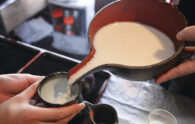Murone, a town located on the eastern edge of Ichinoseki City, Iwate Prefecture, is home to 4400 residents. Abundant in nature, from the night sky being selected by the Japanese Government as one of the top places for stargazing to the dazzling azaleas that decorate Mt. Murone in May. It is also home to a tree-planting ceremony held by NPO “Mori wa Umi no Koibito, (The Forest is longing for the sea, the sea is longing for the forest)” with Kesennuma City, Miyagi Prefecture.

Murone Shrine, located on the eighth station of the prominent 895-meter-high Mount Murone, is a deeply revered shrine and the focal point of the Murone Shrine Grand Festival (室根神社特別大祭, murone-jinja-tokubestu-taisai, or as the locals call it, murone taisai).
History of the festival
Murone Shrine, formerly a prefectural shrine, is dedicated to Izanami-no-Mikoto, creator deity of both creation and death in Japanese mythology, in the main shrine, Hongu, and Hayatama-no-Mikoto, also known as Izanagi no Mikoto, primordial god of creation and life, and Kotosaka-no-ono-Mikoto, God of decision-making and new beginnings, in the newly constructed shrine, Shingu.
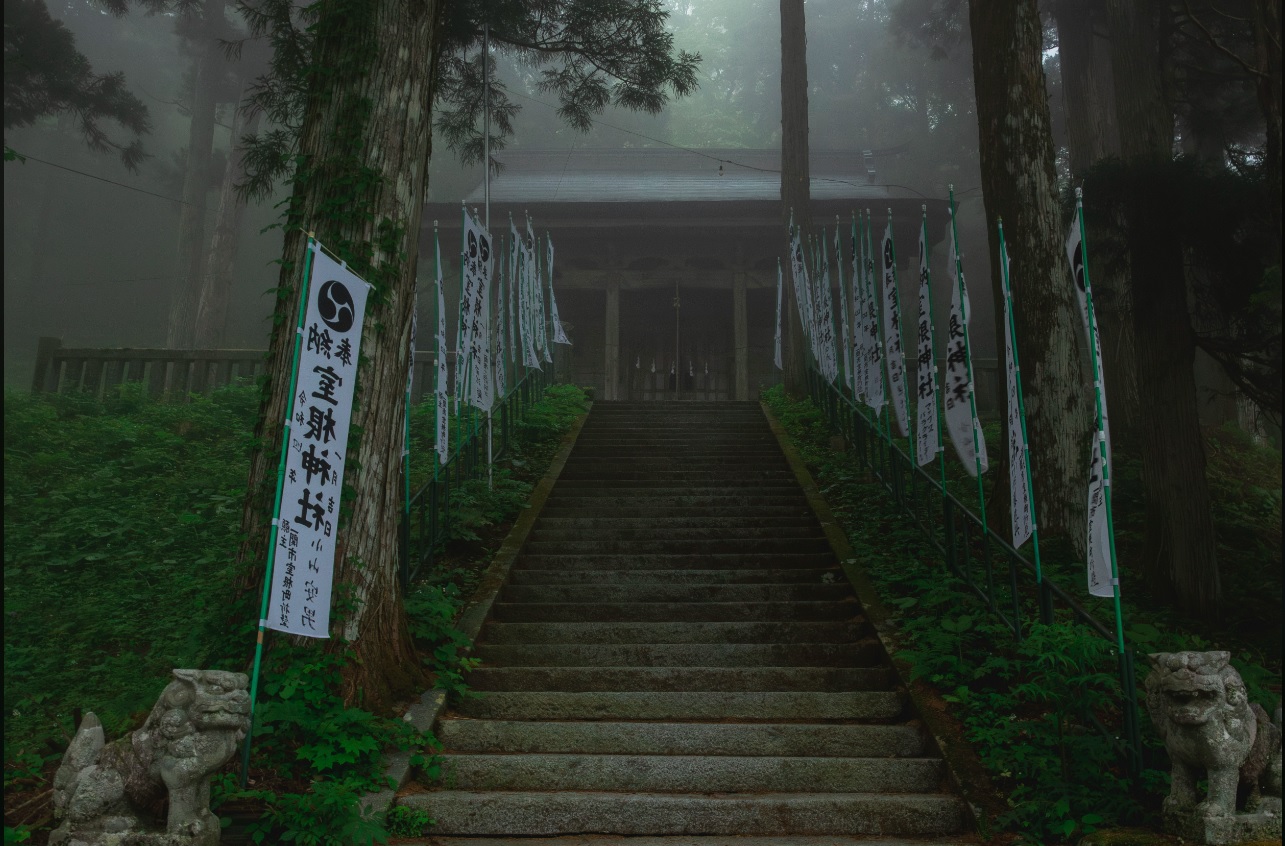
Hongu
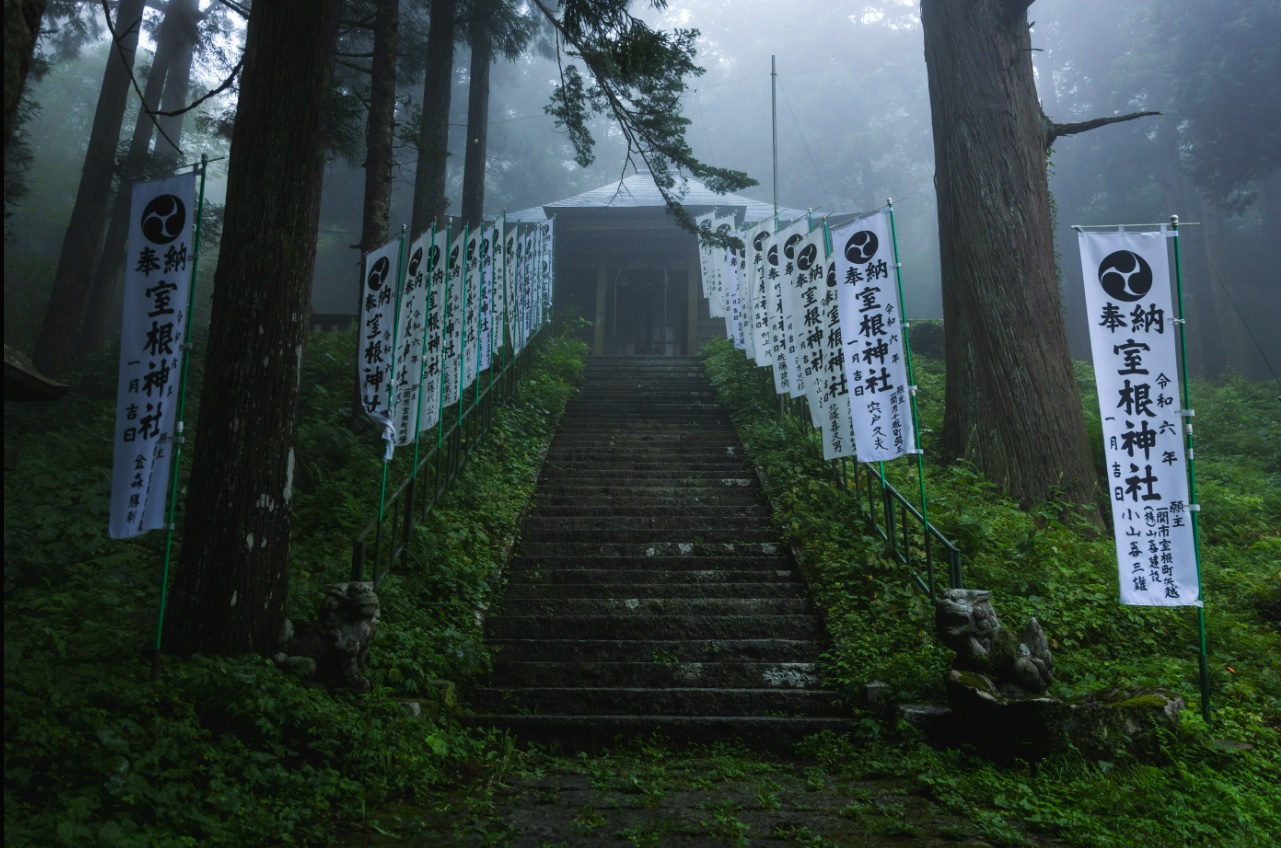
Shingu
The shrine is said to have been founded in 718, when Ono-no-Azumabito, a samurai and court official of Japan’s Nara period was engaged in a campaign against the Emishi people. He requested the Imperial Court to divide and re-enshrine a Kumano deity of Kii Province (now Wakayama Prefecture as well as the southern part of Mie Prefecture) in an attempt to resolve the war.
The deity left Kii Province, crossing the sea, arriving at Hosoura on the Karakuwa Peninsula (present-day Kesennuma City, Miyagi Prefecture), and expressed divine intention to be enshrined on Mount Murone, which was called Onikabeyama at the time.
It is said that Ono, together with the residents of the Murone area, prepared a white horse, and formed a procession. Along the way, the procession was treated to rice porridge, and a temporary shrine was built to welcome the deity. About 600 years on, in 1313, Shingu came to pacify the Seven Ōu Districts (roughly the southern part of Iwate Prefecture).
The reenactment of these several events is what we see at the Murone Shrine Grand Festival, with key rituals continuing for over 1300 year ago.
Murone Shrine Grand Festival


Date of next festival: October 25 (Fri.) to 27 (Sun.), 2024
The Murone Shrine Grand Festival is a large-scale event that has been held continuously since the first Kumano deity was enshrined in 718.
Various roles with distinctive regional features, have carefully been handed down over 1300 years by the descendants of those who welcomed the deities. There are no instructions from the shrine for the preparations for the festival, and each person in an important role, known as a “jinyaku,” carries out the role that has been passed down to them.
For its rare and long preservation of tradition, it is designated as a National Intangible Folk Cultural Asset under the Religious Festivals and Beliefs category. Approximately 1,000 shrine parishioners from the town of Murone and surrounding areas attend the three-day celebration, which takes place in October of the year that follows a leap year on the lunar calendar.
Points of interest
After two days of rituals and events, the culmination occurs on the last day of the festival.


At 3:00 a.m. at Murone Shrine, the deities are transferred to Hongu and Shingu mikoshi (portable shrines).
At 4:00 a.m., the mikoshi depart from Murone Shrine and descend the mountain. As they descend, an agricultural event at the rice planting platform is held.
Divine helpers and their horses strive toward Matsuriba, which is 10 kilometers away, guided by the dim light of lanterns and the sound of taiko drums and Japanese flutes.
At 8:00 a.m., both mikoshi arrive at Matsuriba and battle to be the first to climb the temporary shrine, which is approximately 7 meters high. Once the competition is over, the two mikoshi are installed at the temporary shrine, and a variety of events are held, including Shinto rituals, Maiko dance, and horse performances.
Details of the main event and grand finale for 2024

Competition to carry the mikoshi to the top:
The main event of the festival is the race to install the Hongu and Shingu mikoshi at the temporary shrine.
Date: Oct 27, 2024, from around 7:30am
Location: Matsuriba (follow signs)
Access
Train: 10-minute walk from Orikabe Station on the JR Ofunato Line
Car: Take National Route 284 to Murone-cho Orikabe (special parking available at Murone Branch Office).
This article has been arranged using the information found on muronetaisai.com (JP) and Ichinoseki City Hall HP.
Japanese
室根神社特別大祭 (マツリバ行事)岩手県一関市の東端に位置する室根町は、夜空が国選定の星空の名所に選ばれ、5月には真っ赤なツツジが山を彩る自然豊かな町です。 宮城県気仙沼市と30年以上にわたって開催されている「森は海の恋人」植樹祭の本拠地でもあります。
標高895mの室根山の8合目には、室根神社があります。室根神社は、室根神社特別大祭の中核をなす歴史の深い神社です。
由緒
室根神社は、本宮が伊弉冉命(イザナミノミコト)、新宮が速玉男命(ハヤタマノオノミコト)・事解男命(コトサカノミコト)を祭神とする旧県社です。
当時、多賀城で蝦夷の征伐にあたっていた武将が、苦しい戦況をどうにかしようと、天皇に願い出て、紀伊国(和歌山県と三重県南部)の熊野大社の神様にお越しいただくことになりました。
神は、紀州国を出立し、海を渡たり、唐桑半島の細浦(現宮城県気仙沼市立)に辿り着き、
時首山(おにかべやま)といわれていた室根山に鎮座の神意を表されたので、
大野東人らは矢越の郷民とともに白馬を仕立ててお迎えしたと伝えられています。
その道中で粥をふるまわれるなど、多くの郷民たちの盛んな奉迎をうけ、折壁で仮宮を立て御神霊を安置しました。
「新宮」はそれから約600年後、1313年に奥羽七郡(概ね岩手県の県南地域)を鎮めるために来ました。
その様々な場面を再現するのが「室根神社祭のマツリバ行事(室根神社特別大祭)」になります。
室根神社特別大祭とは、岩手県一関市室根町を中心とした地域に1300年以上前から伝わる祭りです。室根神社の特別大祭は、718年に紀州の熊野から熊野大社の御神霊を勧請して以来、連綿として行われてきたものです。様々な役割が、1300年前に神様をお迎えした者達の子孫らにより連綿と受け継がれている貴重さから国の重要無形民俗文化財にも指定されています。この大祭は神社が仕切るわけでもなければ、中心となる主催者がいるわけでもなく、自ら主体的に集まった参加者が、それぞれ与えられた役割を全うします。
祭りは旧暦の閏年の翌年の10月に3日間通しで開催され、室根町を中心として隣接する地域から、氏子(うじこ)約千人が参加しています。
最終日の午前3時、室根山の8合目にある室根神社で本宮、新宮の両神輿に「御魂移し」が行われます。
午前4時、神輿は室根神社を出発し下山します。下山する途中に、新穀献納式が行われます。提灯の薄明かりと太鼓や笛の音に導かれながら、神馬は夜通し、神社から10キロ先の祭場(まつりば)を目指します。
午前8時、マツリバに到着し、高さ約7mの仮宮を目指し、先着争いを繰り広げます。両神輿が安着され、その後は神事、舞姫舞奉(たちまい)納、馬場巡りなど多彩な催しが行われます。
本宮神輿と新宮神輿のお仮宮への安着を争うのが祭りのメインです。
開催日:室根大祭3日目 7:30頃〜
場所:蛇石の鳥居〜折壁町内〜マツリバ
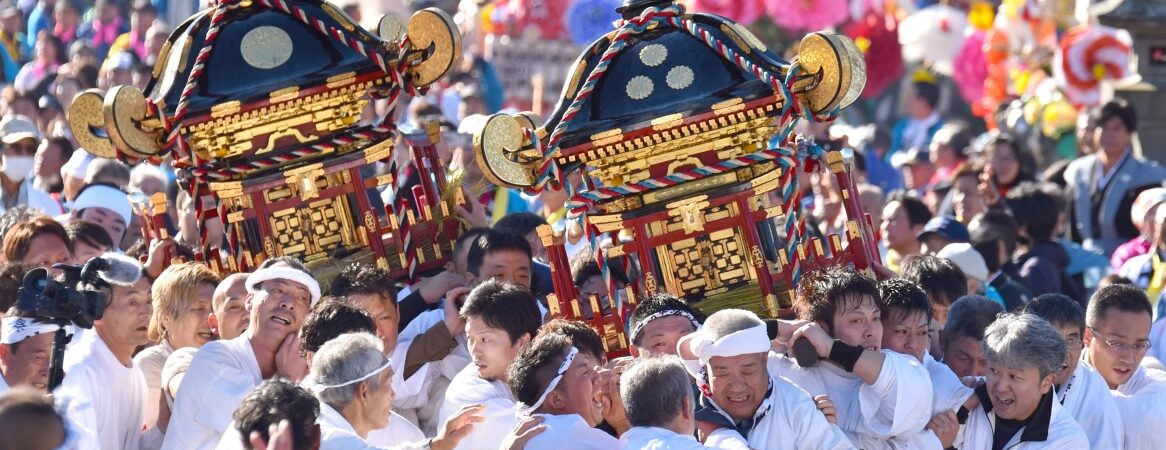
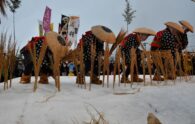
-195x124.jpg)
